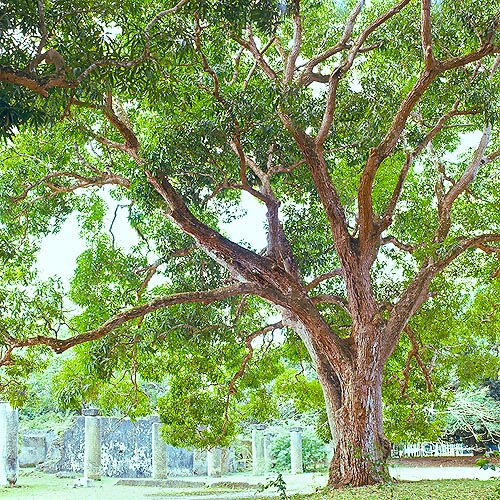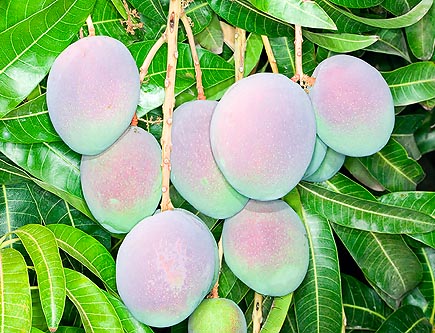Family : Anacardiaceae

Text © Pietro Puccio

English translation by Mario Beltramini

Sri Lanka: imposing specimen of Mangifera indica © Giuseppe Mazza
The name of the genus comes from the combination of one of the local names of the fruit, “manga”, with the Latin verb “fero” = I carry; the Latin name of the species “indica” = of India, refers to one of its areas of origin.
Common names: “mango” (Italian); “Indian mango”, “mango”, “mango-tree” (English); “mangue”, “manguier” (French); “Indischer Mangobaum”, “Mango”, “Mangobaum”, “Mango Palme” (German); “manga”, “mangueira” (Portuguese): “mango” (Spanish).
Evergreen tree, which, when cultivated, is not taller than 10 m, even if in the wild we can find specimen reaching the 30 m of height, with a huge foliage and with a trunk which, in the old specimen, can have a diameter of more than 1 m.
The leaves are rather variable as shape and dimension, but, normally, are elongate, 10-30 cm long and 3-6 cm broad, leathery, of a dark green colour on the upper page, paler on the inferior one.
The new leaves are issued periodically by groups and during the growth assume a bronze to purple red colour, which, gradually, changes to dark green when ripe.
The inflorescences are terminal with a much ramified panicle, 20-35 cm, even longer in some varieties, with peduncles with green to pink to red colour, carrying a great number of pale yellow or purple overspread colour, with a diameter of 6-10 mm; on the same inflorescence do coexist both hermaphrodite and male flowers.
The fruits, on a long pending peduncle, are oblong or kidney-shaped drupes, of a yellowish-green colour, at times overspread of purple red when ripe, long up to 20 cm and 6-8 cm thick; the mesocarp, which is the edible part, rich in vitamins A and C, is juicy and with a colour which varies from the intense yellow to the orange.

Mangifera indica variety Otts © Giuseppe Mazza
It reproduces, usually, by seed, the selected varieties by grafting.
The plant, which is cultivated since the remote times, and of which exist nowadays many hundreds of varieties, is widely spread in all tropical and subtropical countries, mainly for the production of the fruits, but also for its good quality wood, utilized for several purposes, and as shade tree.
For a best production, the plant needs a long dry period before and during the blooming, which happens in the cooler part of the year, as a matter of fact, the decrease of the temperature stimulates the blooming; during this the temperatures should be more than +13°C, in order to favour the pollination.
The plant, particularly in the varieties which resist better to low temperatures, is marginally cultivable in the warm-temperate areas.
Synonyms: Rhus laurina Nutt. (1838); Mangifera austroyunnanensis Hu (1940).
→ To appreciate the biodiversity within the ANACARDIACEAE family please click here.
